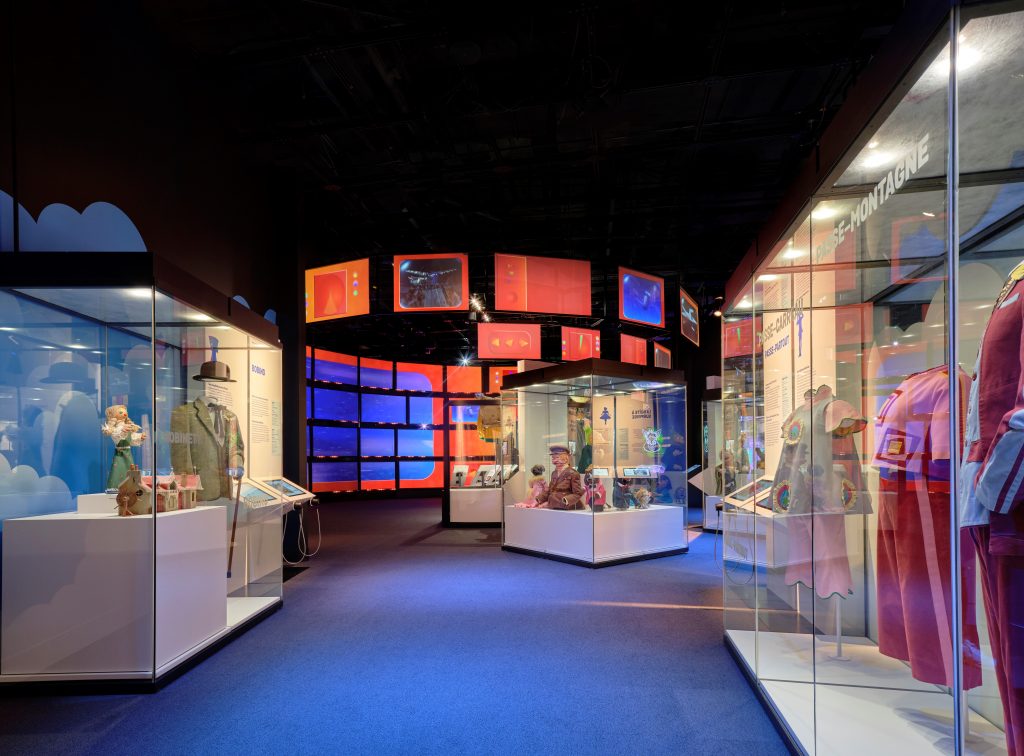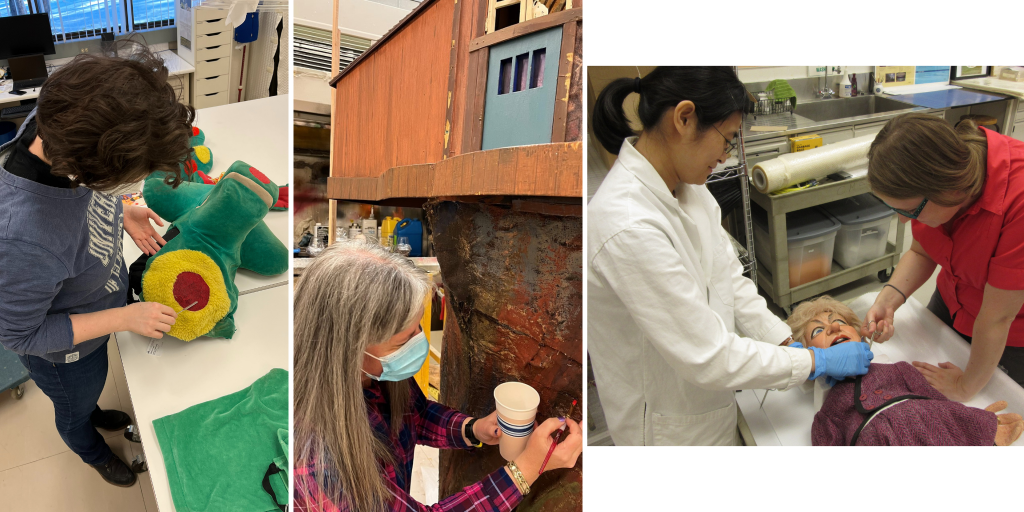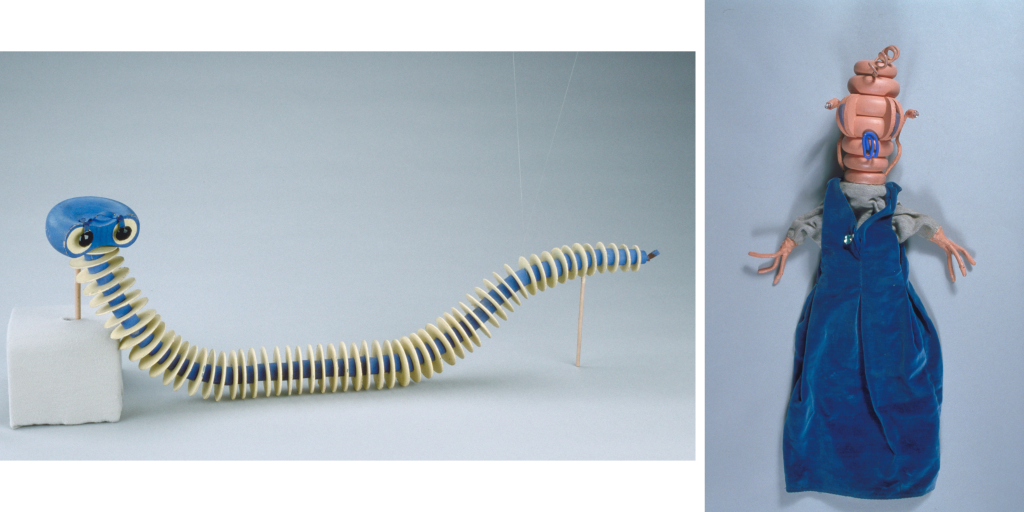We wanted to include everything! Behind the scenes of From Pepinot to PAW Patrol® – Television of our Childhoods
Over the past few years, for the team developing From Pepinot to PAW Patrol® – Television of our Childhoods, the good news was that the history of Canadian children’s television was bigger than we could ever have imagined, and the bad news was that the topic was bigger than we could ever have imagined.
One of our team’s goals was to create a full experience of the rich, diverse history of 70 years of Canadian children’s television for the Canadian Museum of History’s visitors. Space filled up quickly, with so many programs created from coast to coast to coast to consider. From thousands of programs, we squeezed in artifacts from 35 shows and video excerpts from almost 100 shows.
We wanted the exhibition to reconnect visitors with favourite programs from their childhoods and to introduce visitors to wonderful programs that were not part of their generation, or their language or cultural background growing up. Given the richness of the topic, we focused on programs with enduring popularity that were made for national, francophone or anglophone audiences, and for Indigenous communities.

From Pepinot to PAW Patrol® – Television of Our Childhoods, Photo by Janet Kimber
Caring for fragile treasures
A significant challenge that emerged during development of the project was how ephemeral popular culture heritage is. For television artifacts that have survived, it was amazing to see our colleagues — the conservation team at the Museum — treating childhood favourites just as carefully as they would treat any national treasures.

1) Museum textile conservator Brenna Cook examines a damaged polyester net on Polkaroo’s head to determine whether it requires treatment. 2) Museum objects conservator Jennifer Ann Mills applies a treatment to help preserve the exterior walls of Mr. Dressup’s tree house. 3) Museum objects conservator Emily Lin and preventive conservation technician Rebecca Latourell take samples from a puppet in the Museum’s collection. Once the samples are analyzed, they decide on the best treatments.
Ephemeral culture
Puppets, costumes and sets for TV productions are made as working materials, and they may not be saved as cultural heritage. For example, we would still love to find Ciboulette, the clever and affectionate grey cat from Félix et Ciboulette.
As well, physical and digital copies of original recordings may not be archived. In the past, expensive film footage was often reused. The Museum has in the national collection seven puppets from Planet Tolex (made in 1953–1954 by CBC Toronto), a very early science fiction program for children, for which no original footage seems to have survived. The puppets are fantastical, and we can only imagine the wild world and adventures of the residents of Tolex, a planet hidden behind the sun. If anyone has more information, we would love to know!

Worm, rod puppet, Canadian Museum of History, 94-1142. Creators: Dora and Leo Velleman
Space creature, hand puppet, Canadian Museum of History, 94-1908, CD1997-0229-095. Creators: Dora and Leo Velleman

Pearl van Oyster, mouth puppet, Canadian Museum of History, 94-1098 a-b, IMG2008-0014-076.
Creator: Barry Rosenberg
Keeping it professional
As well, we must admit that many of us had personal favourites that we lobbied for. There are so many programs that were delightful, but short-lived or limited in distribution.
For at least one of us, Mrs. Pearl Van Oyster from The Waterville Gang (produced by CTV’s CFTO-TV, 1972-1974), still appears to our inner child as the height of 1970s glamour. We didn’t have space for her or her friends in the exhibition but, fortunately, the show’s aquatic community is housed in the Museum’s collection.
We also had to manage the expectations of our loved ones who wanted to know if memorable parts of their childhoods were being considered, such as The Hilarious House of Frightenstein, the 1971 one-season cult classic from Hamilton’s CHCH-TV that featured Vincent Price, or the early 80s Les voyages de Tortillard (also known as The Secret Railroad), with the animated adventures of a boy who finds a magical steam train in the basement of his apartment building.
We couldn’t include any of these, not because they weren’t amazing, but because there are so many programs of long duration and wide impact to acknowledge.
So much more to tell
Our focus is on storytelling programs that teach children and bring them to rich imaginative worlds. As such, there are still so many other genres to explore:
- Quiz shows: Reach for the Top, Les Satellipopettes (we include the costume but not the quiz challenges)
- News magazines: Les Débrouillards, Street Cents, Razzle Dazzle (we include the hosts waving to viewers, but not their documentary topics)
- Sketch comedy programs: Pop Citrouille, You Can’t Do That on Television, Le Club des 100 watts, Dans une galaxie près de chez vous, Radio Enfer, Une grenade avec ça?
- Regional gems: Yes, we see you The Uncle Bobby Show and Miss Helen
The topic of Canadian children’s television is bigger than we could take on, and we have a very real hope that the exhibition and catalogue will inspire others to research, document and celebrate our popular culture and television heritage.
We appreciate that many fans, experts and institutions are committed to Canada’s rich contributions to popular culture, and there is growing attention to our histories of music, radio, television and other new forms of media.
If anyone is launching a celebration of Canadian popular culture, we would be happy to bring coffee and donuts to the opening! For the history of Canadian children’s television specifically, there is still so much scope for conferences, oral histories, documentaries, coffee-table books, encyclopedias, wikis, and even more exhibitions.
If you visit the exhibition — and we hope you will — we hope that you will find many of your favourites in the video excerpts and in the artifact displays. If there is something personal that is missing, please know that we share your passion for childhood memories of television.
You may also be interested in:
Claire Champ, Olivier Côté, and Carolyn Lecorre are part of the multidisciplinary team that collaborated to create the exhibition.

Claire Champ, Olivier Côté, and Carolyn Lecorre
Claire Champ is a creative development specialist at the Canadian Museum of History. Her work focuses on creating engaging experiences for visitors in exhibitions.
Olivier Côté is the curator responsible for media and communications at the Canadian Museum of History. A television historian, he is particularly interested in children’s programs. For the exhibition, he worked to identify the must-see programs. He did the preliminary research on clips, objects and images for the exhibition, and wrote the first draft of the exhibition texts.
Carolyn Lecorre is a media producer at the Canadian Museum of History. Filming, editing, directing, coordinating, producing — these are all the hats she wore to create this exhibition.